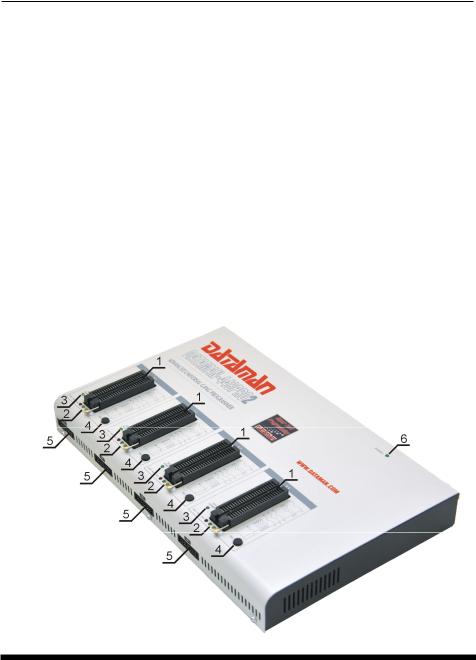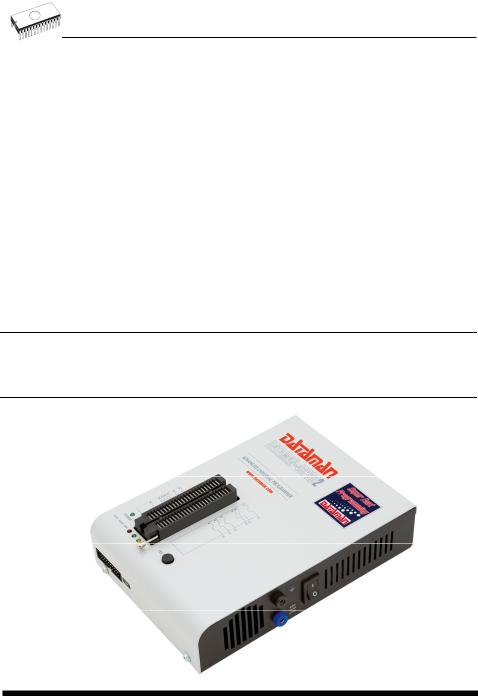Dataman 40Pro User Manual

User manual for
DATAMAN-448PRO2
Super fast universal 4x 48-pindrive concurrent multiprogramming system with ISP capability
DATAMAN-48PRO2
Super fast universal 48-pindrive Programmer with USB/LPT interface and ISP capability
DATAMAN-48PRO2C
Super fast universal 48-pindrive Programmer with USB interface and ISP capability
DATAMAN-40PRO
Universal 40-pindrive Programmer with USB interface and ISP capability
DATAMAN-MEMPRO
Universal memory Programmer
22nd August 2014
1

COPYRIGHT 2014
Dataman Programmers Ltd
This document is copyrighted by Dataman Programmers Ltd, United Kingdom. All rights reserved. This document or any part of it may not be copied, reproduced or translated in any form or in any way without the prior written permission of Dataman Programmers Ltd.
The control program is copyrighted by Dataman Programmers Ltd. The control program or any part of it may not be analyzed, disassembled or modified in any form, on any medium, for any purpose.
Information provided in this manual is intended to be accurate at the moment of release, but we continuously improve all our products. Please check for an updated manual on our website at www.dataman.com.
Dataman Programmers Ltd assumes no responsibility for misuse of this manual.
Dataman Programmers Ltd reserves the right to make changes or improvements to the product described in this manual at any time without notice. This manual contains names of companies, software products, etc., which may be trademarks of their respective owners. Dataman Programmers Ltd respects those trademarks.
ZLI-0305E
2

How to use this manual
This manual explains how to install the control program and how to use your programmer. It is assumed that the user has some experience with PCs and installation of software. Once you have installed the control program we recommend you consult the context sensitive HELP within the control program rather than the printed User manual. Revisions are implemented in the context sensitive help before the printed User manual.
_____________________________________
We continuously update our manual. You may find the latest version from our website (www.dataman.com).
3

Table of contents |
|
How to use this manual ...................................................................................................................... |
3 |
Introduction............................................................................................................................................ |
7 |
Products configuration ........................................................................................................................ |
9 |
PC requirements ............................................................................................................................... |
10 |
Free additional services:................................................................................................................... |
11 |
Quick Start............................................................................................................................................ |
12 |
Detailed description ............................................................................................................................ |
15 |
DATAMAN-448PRO2 ........................................................................................................................... |
16 |
Introduction ....................................................................................................................................... |
17 |
DATAMAN-448PRO2 elements ....................................................................................................... |
19 |
Manipulation with the programmed device ...................................................................................... |
20 |
In-system serial programming by DATAMAN-448PRO2 ................................................................ |
20 |
Selftest .............................................................................................................................................. |
23 |
Technical specification...................................................................................................................... |
23 |
DATAMAN-48PRO2 / DATAMAN-48PRO2C ..................................................................................... |
30 |
Introduction ....................................................................................................................................... |
31 |
DATAMAN-48PRO2 / DATAMAN-48PRO2C elements .................................................................. |
33 |
Connecting DATAMAN-48PRO2 / DATAMAN-48PRO2C to the PC.............................................. |
34 |
Manipulation with the programmed device ...................................................................................... |
35 |
In-system serial programming by DATAMAN-48PRO2 / DATAMAN-48PRO2C ........................... |
36 |
Multiprogramming by DATAMAN-48PRO2 / DATAMAN-48PRO2C .............................................. |
38 |
Selftest .............................................................................................................................................. |
38 |
Technical specification...................................................................................................................... |
39 |
DATAMAN-40PRO ............................................................................................................................... |
45 |
Introduction ....................................................................................................................................... |
46 |
DATAMAN-40PRO elements ........................................................................................................... |
47 |
Connecting DATAMAN-40PRO to PC ............................................................................................. |
48 |
Manipulation with the programmed device ...................................................................................... |
48 |
In-system serial programming by DATAMAN-40PRO..................................................................... |
49 |
Selftest .............................................................................................................................................. |
50 |
Technical specification...................................................................................................................... |
50 |
DATAMAN-MEMPRO........................................................................................................................... |
54 |
Introduction ....................................................................................................................................... |
55 |
DATAMAN-MEMPRO elements....................................................................................................... |
56 |
Connecting DATAMAN-MEMPRO to PC......................................................................................... |
57 |
Manipulation with the programmed device ...................................................................................... |
57 |
Selftest .............................................................................................................................................. |
57 |
Technical specification...................................................................................................................... |
58 |
Setup ..................................................................................................................................................... |
61 |
Software setup .................................................................................................................................. |
62 |
Hardware setup................................................................................................................................. |
68 |
PG4UW.................................................................................................................................................. |
72 |
PG4UW-the programmer software................................................................................................... |
73 |
File..................................................................................................................................................... |
76 |
Buffer ................................................................................................................................................. |
83 |
Device ............................................................................................................................................... |
90 |
Programmer .................................................................................................................................... |
120 |
Options ............................................................................................................................................ |
126 |
Help ................................................................................................................................................. |
139 |
4

PG4UWMC ......................................................................................................................................... |
141 |
Common notes.................................................................................................................................. |
159 |
Maintenance................................................................................................................................... |
160 |
Software ......................................................................................................................................... |
161 |
Hardware ........................................................................................................................................ |
167 |
ISP (In-System Programming)....................................................................................................... |
167 |
Other............................................................................................................................................... |
169 |
Troubleshooting and warranty ....................................................................................................... |
171 |
Troubleshooting ............................................................................................................................. |
172 |
If you have an unsupported target device ..................................................................................... |
172 |
Warranty terms............................................................................................................................... |
173 |
5

Conventions used in the manual
References to the control program functions are in bold, e.g. Load, File, Device, etc. References to control keys are written in brackets <>, e.g. <F1>.
Terminology used in the manual:
Device |
any kind of programmable integrated circuits or programmable devices |
ZIF socket |
Zero Insertion Force socket used for insertion of target device |
Buffer |
part of memory or disk, used for temporary data storage |
Printer port |
type of PC port (parallel), which is primarily dedicated for printer |
USB port |
connection. |
type of PC port (serial), which is dedicated for connecting portable and |
|
HEX data format |
peripheral devices. |
format of data file, which may be read with standard text viewers; e.g. |
|
|
byte 5AH is stored as characters '5' and 'A', which mean bytes 35H and |
|
41H. One line of this HEX file (one record) contains start address and |
|
data bytes. All records are secured with checksum. |
6

Quick Start
Introduction
7

This user manual covers the following programmers: DATAMAN-448PRO2, DATAMAN-48PRO2, DATAMAN-48PRO2C, DATAMAN-40PRO and DATAMAN-MEMPRO
DATAMAN-448PRO2 is a super fast universal 4x 48-pindrive concurrent multiprogramming system designed for high volume production programming with minimal operator effort. The chips are programmed at near theoretical maximum programming speed. Using build-in in-circuit serial programming (ISP) connectors the programmer is able to program ISP capable chips in-circuit.
DATAMAN-48PRO2 is a super fast universal USB/LPT interfaced universal programmer and logic IC tester with 48 powerful pindrivers. Using build-in ISP connector the programmer is able to program ISP capable chips in-circuit. This design allows easily add new devices to the device list. DATAMAN-48PRO2 is a true universal and a true low cost programmer, providing one of the best "value for money" in today's market.
DATAMAN-48PRO2C is a cost effective version of DATAMAN-48PRO2 programmer (without some special devices and LPT port interface). If you need program some of the mentioned devices, please take a look at DATAMAN-48PRO2 programmer.
DATAMAN-40PRO is a small, fast and powerful USB interfaced programmer of all kinds of programmable devices. Using build-in in-circuit serial programming (ISP) connector the programmer is able to program ISP capable chips in-circuit. It has design, which allows easily add new devices to the device list.
DATAMAN-MEMPRO is a small, fast and powerful USB interfaced programmer for EPROM, EEPROM, Flash EPROM, NVRAM, serial EEPROM and static RAM tester. DATAMAN-MEMPRO can be upgraded to DATAMAN-40PRO.
All our programmers work with almost any IBM PC Pentium compatible or higher, portable or desktop personal computers. Programmers use the USB port or parallel (printer) port of PC.
All programmers function flawlessly on Windows operating system (see section PC requirement).
All programmers are driven by an easy-to-use, control program with pull-down menus, hot keys and online help. Control program is common for all the above mentioned programmers.
Advanced design, including protection circuits, original brand components and careful manufacturing allows us to provide a three year warranty for DATAMAN-448PRO2, DATAMAN-48PRO2, DATAMAN-48PRO2C and DATAMAN-40PRO and one year warranty for DATAMAN-MEMPRO on parts and labour for the programmers (limited 25,000 cycle warranty on ZIF socket). This warranty terms are valid for customers, who purchase a programmer directly from Dataman company. The warranty conditions of Dataman distributors may be different and depending the law system or reseller’s warranty policy.
8

Quick Start
Products configuration
Before installing and using your programmer, please carefully check that your package includes all next mentioned parts. If you find any discrepancy with respective parts list and/or if any of these items are damaged, please contact your distributor immediately.
|
|
DATAMAN-448PRO2 |
DATAMAN-48PRO2 |
DATAMAN-48PRO2C |
DATAMAN-40PRO |
DATAMAN-MEMPRO |
|
|
|
|
|
|
|
|
programmer |
|
|
|
|
|
|
USB cable |
|
|
|
|
|
|
LPT cable |
- |
* |
- |
- |
- |
|
ISP cable |
4x |
|
|
|
|
|
power cordset |
|
|
|
|
|
|
internal power supply |
|
|
|
- |
- |
|
external power supply |
- |
- |
- |
|
|
|
48 pins diagnostic POD – type I |
1x |
|
|
- |
- |
|
40 pins diagnostic POD – type I |
- |
- |
- |
|
|
|
Diagnostic POD for ISP connectors #2 |
1x |
|
|
- |
- |
|
ZIF anti-dust cover |
4x |
|
|
|
|
|
software CD |
|
|
|
|
|
|
User manual |
|
|
|
- |
- |
|
Quick Guide |
|
|
|
|
|
|
brochure Notes about ESD |
|
|
|
|
|
|
antistatic set |
|
- |
- |
|
|
|
vacuum handling tool kit |
|
- |
- |
|
|
|
sticker register your programmer |
|
|
|
|
|
|
shipping case |
|
|
|
|
|
* |
optional accessories |
|
|
|
|
|
9

PC requirements
Minimal PC requirements
|
|
2x DATAMAN-448PRO2 |
DATAMAN-448PRO2 |
DATAMAN-48PRO2 DATAMAN-48PRO2C |
DATAMAN-40PRO |
DATAMAN-MEMPRO |
|
|
|
|
|
|
|
|
OS - Windows |
XP |
2000 |
2000 |
2000 |
2000 |
|
CPU |
C2D 2,6GHz |
P4 |
P4 |
P4 |
P4 |
|
RAM [MB] |
1000 |
1000 |
512 |
512 |
512 |
|
free disk space [MB] |
1000 |
400 |
400 |
400 |
400 |
|
USB 2.0 high speed |
|
|
- |
- |
- |
|
USB 1.1 |
- |
- |
|
|
|
|
LPT |
- |
- |
|
- |
- |
|
CDROM |
|
|
|
|
|
Recommended PC requirements |
|
|
|
|
||
|
|
|
|
|
|
|
|
|
2x DATAMAN-448PRO2 |
DATAMAN-448PRO2 |
DATAMAN-48PRO2 DATAMAN-48PRO2C |
DATAMAN-40PRO |
DATAMAN-MEMPRO |
|
|
|
|
|
|
|
|
OS - Windows |
Win 7 |
Win 7 |
Win 7 |
Win 7 |
Win 7 |
|
CPU |
C2Quad |
C2D |
C2D |
C2D |
C2D |
|
RAM [MB] |
2000 |
1000 |
1000 |
512 |
512 |
|
free disk space [MB] |
2000 |
1000 |
1000 |
1000 |
1000 |
|
USB 2.0 high speed |
|
|
|
|
|
|
2x USB 2.0 high |
|
|
|
|
|
|
speed controllers |
|
|
|
|
|
|
|
|
|
|
|
|
These PC requirements are valid for 3.02 version of control program for programmers (issued 17/DEC/2013) and above.
If two programmers are to be connected to a single PC, then we strongly recommend to connect each programmer to separate USB 2.0 High speed controller (USB EHCI). For more information see "Hardware setup" chapter.
10

Quick Start
Free disk space requirement depends also on used IC device size and number of attached programming sites. For large devices the required free space on disk will be approximately
1000MB + 2x Device size x number of programming sites attached to this PC.
Very easy indication, if your PC in hardware/software configuration is good enough for the current software version and current situation with PG4UW/PG4UWMC, is to run Windows task manager (Ctrl+Alt+Del) and see the performance folder. It have to be max. 80% of CPU usage at full run of programming system.
Note: For convenience, we suggest that you use a supplementary multi I/O card to provide an additional printer port (LPT2 for example), in order to avoid sharing the same LPT port between printer and programmer.
Free additional services:
free technical support (phone/fax/e-mail).
free lifetime software update via Web site.
Free software updates are available from our
Internet address www.dataman.com.
11

Quick Start
12

Quick Start
Installing programmer hardware
connect the USB (or LPT) port of programmer to a USB (or printer) port of PC using supplied cable
connect the connector of the power supply adapter to the programmer or turn on programmer by switch
Installing the programmer software
Run the installation program from the CD (Setup.exe) and follow the on-screen instructions. For the latest information about the programmer hardware and software release, please visit our website www.dataman.com.
Run the control program
Double click on
After start, control program PG4UW automatically scans all existing ports and searches for any connected DATAMAN programmer. Program PG4UW is common for some the DATAMAN's programmers, hence PG4UW will try to find all supported programmers.
Menu File is used for source files manipulation, settings and viewing directory, changes drives, changes start and finish address of buffer for loading and saving files and loading and saving projects.
Menu Buffer is used for buffer manipulation, block operation, filling a part of buffer with string, erasing, checksum and of course editing and viewing with other items (find and replace string, printing...).
Menu Device is used for a work with selected programmable device: select, read, blank check, program, verify, erase and setting of programming process, serialization and associated file control.
Menu Programmer is used for work with programmer.
Menu Options is used to view and change various default settings.
Menu Help is used for view supported devices and programmers and information about program version.
Programming a device
1.select device: click on 
2.load data into buffer:
a)from file: click on 
b)from device: insert device to ZIF and click
3.insert target device to ZIF
13

4.check, if the device is blank: click on 
5.program device: click on 
6.additional verify of device: click on 
14

Detailed description
Detailed description
15

DATAMAN-448PRO2
16

DATAMAN-448PRO2
Introduction
DATAMAN-448PRO2 is very fast universal 4x 48-pindrive concurrent multiprogramming system designed for high volume production programming with minimal operator effort. The chips are programmed at near theoretical maximum programming speed.
DATAMAN-448PRO2 consist of four independent isolated universal programming modules, based on the DATAMAN-48PRO2 programmer hardware. Therefore the sockets can run asynchronously (concurrent programming mode). Each programming module starts programming at the moment the chip is detected to be inserted in the socket properly - independently on the status of other programming modules. It result three programming modules works while you replace the programmed chip at the fourth.
Modular construction of hardware - the programming modules works independently - allows for continuing operation when a part of the circuit becomes inoperable. It also makes service quick and easy.
Hands-free operation: asynchronous and concurrent operation allows a chip to begin programming immediately upon insertion of a chip. The operator merely removes the finished chip and inserts a new chip. Operator training is therefore minimized...
DATAMAN-448PRO2 support all kinds of types and silicon technologies of today and tomorrow programmable devices without family-specific module. You can be sure the next devices support require the software update and (if necessary) simple package converter (programming adapter), therefore the ownership cost are minimized.
Using built-in in-circuit serial programming (ISP) connector, the programmer is able to program ISP capable chips in circuit.
DATAMAN-448PRO2 provide very competitive price coupled with excellent hardware design for reliable programming. It has probably best "value for money" programmer in this class.
DATAMAN-448PRO2 provide very fast programming due to high-speed FPGA driven hardware and execution of time-critical routines inside of the programmer. It is at least so fast than competitors in this category, for many chips much faster than most competitors. As a result, when used in production this programmer waits for an operator, and not the other way round.
DATAMAN-448PRO2 interfaces with the IBM PC/compatible, portable or desktop personal computers through USB (2.0) port.
DATAMAN-448PRO2 provides a banana jack for ESD wrist straps connection to easy-to- implement the ESD protection control and also other banana jack for earth wire.
FPGA based totally reconfigurable 48 powerful TTL pindrivers provide H/L/pull_up/pull_down and read capability for each pin of socket. Advanced pindrivers incorporate high-quality highspeed circuitry to deliver signals without overshoot or ground bounce for all supported devices. Pin drivers operate down to 1.8V so you'll be ready to program the full range of today's advanced low-voltage devices.
17

DATAMAN-448PRO2 performs on each programming module device insertion test (wrong or backward position) and contact check (poor contact pin-to-socket) before it programs each device. These capabilities, supported by overcurrent protection and signature-byte check help prevent chip damage due to operator error.
DATAMAN-448PRO2 have the selftest capability, which allows run diagnostic part of software to thoroughly check the health of the each programming module.
DATAMAN-448PRO2 have a built-in protection circuits for eliminate damage of programmer and/or programmed device due to environment or operator failure. All ZIF socket pins of DATAMAN-448PRO2 programmer are protected against ESD up to 15kV.
When programming specification require, the (DATAMAN-448PRO2) programmer performs programming verification at the marginal level of supply voltage, which, obviously, improves programming yield, and guarantees long data retention.
Various socket converters are available to handle device in PLCC, SOIC, PSOP, SSOP, TSOP, TSSOP, TQFP, QFN (MLF), SDIP, BGA and other packages.
DATAMAN-448PRO2 programmer is driven by an easy-to-use control program with pulldown menu, hot keys and on-line help. Selecting of device is performed by its class, by manufacturer or simply by typing a fragment of vendor name and/or part number.
Standard device-related commands (read, blank check, program, verify, erase) are boosted by some test functions (insertion test, signature-byte check), and some special functions (autoincrement, production mode - start immediately after insertion of chip into socket).
All known data formats are supported. Automatic file format detection and conversion during load of file.
The rich-featured autoincrement function enables to assign individual serial numbers to each programmed device - or simply increments a serial number, or the function enables to read serial numbers or any programmed device identification signatures from a file.
The software also provides a lot of information about programmed device. As a special, the drawings of all available packages, explanation of chip labeling (the meaning of prefixes and suffixes at the chips) for each supported chip are provided.
The software provide full information for ISP implementation: Description of ISP connector pins for currently selected chip, recommended target design around in-circuit programmed chip and other necessary information.
The remote control feature allows PG4UW software to be flow controlled by other application – either using .BAT file commands or using DLL file. For DATAMAN-448PRO2 is remote control limited for ISP programming only.
Jam files of JEDEC standard JESD-71 are interpreted by Jam Player. Jam files are generated by design software which is provided by manufacturer of respective programmable device. Chips are programmed in ZIF or through ISP connector (IEEE 1149.1 Joint Test Action Group (JTAG) interface).
18

DATAMAN-448PRO2
VME files are interpreted by VME Player. VME file is a compressed binary variation of SVF file and contains high-level IEEE 1149.1 bus operations. VME files are generated by design software which is provided by manufacturer of respective programmable device. Chips are programmed in ZIF or through ISP connector (IEEE 1149.1 Joint Test Action Group (JTAG) interface).
Multiple devices are possible to program and test via JTAG chain: JTAG chain (ISP-Jam) or JTAG chain (ISP-VME).
It is important to remember that in most cases new devices require only a software update due to the DATAMAN-448PRO2 is truly universal programmer. With our prompt service you can have new devices can be added to the current list within hours!
Advanced design including protection circuits, original brand components and careful manufacturing and burning allows us to provide a three-year warranty on parts and labor for the DATAMAN-448PRO2 (limited 25,000-cycle warranty on ZIF socket).
DATAMAN-448PRO2 elements
1)48 pin ZIF socket
2)work result LEDs
3)power/sleep LED of site
4)YES! Button
5)ISP connector
6)LED indicator power
19

7)power supply connector
8)power switch
9)"GND" connector can be used for grounding of the programmer "ESD wrist strap" connector is place for attaching of ESD wrist strap
10)temperature controlled fans
11)type B USB connector for PC DATAMAN-448PRO2 communication cable
Manipulation with the programmed device
After selection of desired device for your work, you can insert it into the open ZIF socket (the lever is up) and close socket (the lever is down). The correct orientation of the programmed device in ZIF socket is shown on the picture near ZIF socket on the programmer's cover. The programmed device is necessary to insert into the socket also to remove from the socket when LED BUSY light off.
Note: Programmer's protection electronics protect the target device and the programmer itself against either short or long-term power failures and, partly, also against a PC failure. However, it is not possible to grant the integrity of the target device due to incorrect, userselected programming parameters. Target device may be not destroyed by forced interruption of the control program (reset or switch-off PC), by removing the physical connection to the programmer, but the content of actually programmed cell may remains undefined. Don't unplug the target device from the ZIF socket during work with devices (LED BUSY shine).
In-system serial programming by
DATAMAN-448PRO2
Optimized advanced pindriver deliver programming performance without overshoot or ground bounce for all device technologies. Pin drivers operate down to 1.8V so you'll be ready to program the full range of today's advanced lowvoltage devices.
The ISP programming solution performs programming verification at the marginal level of supply voltage, which, obviously, improves programming yield, and guarantees long data retention.
The ISP programming solution provides also the power supply for the target system.
The software provide full information for ISP implementation: Description of ISP connector pins for currently selected chip, recommended target design around in-circuit programmed chip and other necessary information.
20

DATAMAN-448PRO2
For general definition, recommendation and direction about ISP see section Common notes / ISP please.
Description of ISP connector
As ISP connector is used 20 pins connector 2-1634689-0 from TE connectivity or other compatible connector.
2 4 6 8 10 12 14 16 18 20
1 3 5 7 9 11 13 15 17 19
Front view at ISP connector.
H/L/read driver
|
|
|
|
|
|
|
|
|
|
|
|
|
|
|
|
|
|
|
|
|
|
|
|
|
|
|
|
|
|
|
|
|
|
|
|
|
|
|
|
|
|
|
|
|
|
|
|
|
|
|
|
|
|
|
|
|
|
|
|
|
|
|
|
|
|
|
|
|
|
|
|
|
|
|
|
|
|
|
|
|
|
|
|
|
pins 3, 5, 7, 9, 11, 13 of ISP connector |
|
|
|
|
|
|
|
pin 14 of ISP connector |
|
|
||||||||||||||||||||||||||||||||||||||||||||||||||||||||||
|
|
|
A) |
|
|
|
|
|
|
|
|
|
|
|
|
|
pin of ISP |
|
|
B) |
|
|
|
|
pin of ISP |
|
|
|||||||||||||||||||||||||||||||||||||||||||||||||
|
|
|
|
|
|
drivers in programmer |
|
|
|
|
|
|
|
|
|
|
|
|
|
|
|
drivers in programmer |
|
|
|
|
|
|
||||||||||||||||||||||||||||||||||||||||||||||||
|
|
H/L |
RA1 |
|
|
|
|
|
connector |
|
|
|
|
|
|
|
|
|
|
|
|
|
|
|
|
VCC |
|
|
|
|
connector |
|
|
|||||||||||||||||||||||||||||||||||||||||||
|
|
Float |
RA2 |
|
|
|
|
|
|
|
|
|
|
|
|
|
|
|
|
|
|
|
|
|
RB1 |
RB2 |
|
|
||||||||||||||||||||||||||||||||||||||||||||||||
|
|
|
|
|
|
|
|
|
|
|
|
|
|
|
|
|
|
|
|
|
|
|
|
|
||||||||||||||||||||||||||||||||||||||||||||||||||||
|
|
|
|
|
|
|
|
|
|
|
|
|
|
|
|
|
|
|
|
|
|
|
|
|
||||||||||||||||||||||||||||||||||||||||||||||||||||
|
|
Read |
|
|
|
|
|
|
|
|
|
|
|
|
|
|
|
|
|
|
|
|
|
|
YES! |
|
|
|||||||||||||||||||||||||||||||||||||||||||||||||
|
|
Pull-up/ |
RA3 |
|
|
|
|
|
|
|
|
|
|
|
|
|
|
|
|
|
|
|
|
|
|
|
|
|
|
|
|
|
|
|
|
|
|
|
||||||||||||||||||||||||||||||||||||||
|
|
|
|
|
|
|
|
|
|
|
|
|
|
|
|
|
|
|
|
|
|
|
|
|
|
|
|
|
|
|
|
|
|
|
|
|
||||||||||||||||||||||||||||||||||||||||
|
|
|
|
|
|
|
|
|
|
|
|
|
|
|
|
|
|
|
|
|
|
|
|
|
|
|
|
|
|
|
|
|
|
|
|
|
||||||||||||||||||||||||||||||||||||||||
|
|
Pull-down |
|
|
|
|
|
|
|
|
|
|
|
|
|
|
|
|
|
|
|
|
|
|
|
|
|
|
|
|
|
GND |
|
|
|
|
|
|
|
|
|
|
||||||||||||||||||||||||||||||||||
|
|
|
|
|
|
|
|
|
|
|
|
|
|
|
|
|
|
|
|
|
|
|
|
|
|
|
|
|
|
|
|
|
|
|
|
|
|
|
|
|
|
|
|
|
|
|
|
|
|
|
|
|
|
|
|
|
|
|
|
|
|
|
|
|
|
|
|
|
|
|
|
|
|
|||
|
|
|
|
|
|
|
|
|
|
|
|
|
|
|
|
|
|
|
|
|
|
|
|
|
|
|
|
|
|
|
|
|
|
|
|
|
|
|
|
|
|
|
|
|
|
|
|
|
|
|
|
|
|
|
|
|
|
|
|
|
|
|
|
|
|
|
|
|
|
|
|
|
|
|||
|
|
|
|
|
|
|
|
|
|
|
|
|
|
|
|
|
|
|
|
|
|
|
|
|
|
|
|
|
|
|
|
|
|
|
|
|
|
|
|
|
|
|
|
|
|
|
|
|
|
|
|
|
|
|
|
|
|
|
|
|
|
|
|
|
|
|
|
|
|
|
|
|
|
|
|
|
|
|
|
|
|
|
|
|
|
|
|
|
|
|
|
|
|
|
|
|
|
|
|
|
|
|
|
|
|
|
|
|
|
|
|
|
|
|
|
|
|
|
|
|
|
|
|
|
|
|
|
|
|
|
|
|
|
|
|
|
|
|
|
|
|
|
|
||||||||||
|
|
|
|
|
|
|
|
|
|
|
|
|
|
|
|
|
|
|
|
|
|
|
|
|
|
|
|
|
|
|
|
|
|
|
pins 15, 16 of ISP connector |
|
|
|
|
|
|
|
|
|
|
|||||||||||||||||||||||||||||||
|
|
|
|
|
|
|
|
|
|
|
|
|
|
|
|
|
|
|
|
|
|
|
|
|
|
|
|
|
|
|
|
|
|
|
|
|
|
|
|
|
|
|
|
|
||||||||||||||||||||||||||||||||
|
|
|
C) |
CC1 |
|
|
|
|
|
|
|
|
|
|
|
|
|
|
|
|
D) |
|
|
|
|
|
|
|
|
|
|
|||||||||||||||||||||||||||||||||||||||||||||
|
|
|
|
|
|
|
|
|
|
|
|
|
|
|
|
|
|
|
|
|
|
|
|
|
|
|
|
|
||||||||||||||||||||||||||||||||||||||||||||||||
|
|
|
|
|
|
|
|
drivers in programmer |
|
|
|
|
|
|
pin of ISP |
|
|
|
|
|
|
|
|
|
|
|
|
|
|
|
|
|
|
|
|
|
pin of ISP |
|
|
|||||||||||||||||||||||||||||||||||||
|
|
H/L |
|
|
|
|
|
|
|
|
|
|
|
|
|
|
connector |
|
|
|
|
|
|
|
|
|
|
RD1 |
|
|
|
connector |
|
|
||||||||||||||||||||||||||||||||||||||||||
|
|
Float |
RC1 |
|
|
|
|
|
|
|
|
|
|
|
|
|
|
|
|
|
|
|
|
|
GND |
|
|
|
|
|
|
|
|
|
|
|||||||||||||||||||||||||||||||||||||||||
|
|
|
|
|
|
|
|
|
|
|
|
|
|
|
|
|
|
|
|
|
|
|
|
|
|
|
|
|
|
|
|
|
||||||||||||||||||||||||||||||||||||||||||||
|
|
|
|
|
|
|
|
|
|
|
|
|
|
|
|
|
|
|
|
|
|
|
|
|
|
|
|
|
|
|
|
|
|
|
|
|
|
|
|
|
||||||||||||||||||||||||||||||||||||
|
|
Read |
|
|
|
|
|
|
|
|
|
|
|
|
|
|
|
|
|
|
|
|
|
|
|
|
E) |
|
|
|
pin of ISP |
|
|
|||||||||||||||||||||||||||||||||||||||||||
|
|
|
|
|
|
|
|
|
|
|
|
|
|
|
|
|
|
|
|
|
|
|
|
|
|
|
|
|
|
|
||||||||||||||||||||||||||||||||||||||||||||||
|
|
|
|
|
|
|
|
|
|
|
|
|
|
|
|
|
|
|
|
|
|
|
|
|
|
|
|
|
|
|
||||||||||||||||||||||||||||||||||||||||||||||
|
|
|
|
|
|
|
|
|
|
|
|
|
|
|
|
|
|
|
|
|
|
|
|
|
|
|
|
|
|
|
|
|
|
|
|
|
|
|
|
|
|
|
|
|
|
|
|
|
|
|
|
|
|
|
|
|
|
|
|
|
|
|
|
|
|
|
|
|
|
|
|
|||||
|
|
Pull-up/ |
|
|
|
|
|
|
|
|
|
|
|
|
|
|
|
|
|
|
|
|
|
|
|
|
|
|
|
|
|
|
|
|
|
|
|
CE1 |
|
|
|
connector |
|
|
||||||||||||||||||||||||||||||||
|
|
RC2 |
|
|
|
|
|
|
|
|
|
|
|
|
|
|
|
|
H/L |
|
|
|
|
|
|
|
|
|
|
|||||||||||||||||||||||||||||||||||||||||||||||
|
|
Pull-down |
|
|
|
|
|
|
|
|
|
|
|
|
|
|
|
|
|
|
|
|
|
|
|
|
|
|
|
|
|
|
|
|
|
|
|
|
|
|
|
|
|
|
||||||||||||||||||||||||||||||||
|
|
|
|
|
|
|
|
|
|
|
|
|
|
|
|
|
|
|
|
|
|
|
|
|
|
|
|
|
|
|
|
|
|
|
|
|
|
|
|
|
|
|
|
|
|
|
|
|
|
|
|
|
|
|
|
|
|
|
|
|
|
|
|
|
|
|
|
|
|
|
|
|
|
|
|
|
RE1
RA1 180R, RA2 1k3, RA3 22k,
RB1 10k, RB2 10k,
CC1 1n, RC1 1k3, RC2 22k,
RD1 22k, CE1 1n, RE1 1k3,
Comment to above picture:
picture C) Connection of pins 15 and 16 when are configured as logical signal needed for ISP programming
pictures D) E) When pins 15 and 16 are configured as status of LED OK and LED ERROR picture D) before first action with desired ISP device
picture E) after first action with desired ISP device
21

Notes: When LED OK or LED ERROR ON (shine), this status is presented as logical H, level of H is 1,8V - 5V depend on H level of desired ISP device.
When LED OK or LED ERROR OFF (not shine), this status is presented as logical L, level of L is 0V - 0,4V.
The above mentioned values are provided to understand (and also to exactly calculate) the value of resistors, which isolate (separate) the programmed chip and target system.
Specification of ISP connector pins depends on the device, which you want to program. You can find it in the control SW for programmer (PG4UW), menu Device / Device Info (Ctrl+F1). Be aware, the ISP programming way of respective device must be selected. It is indicated by (ISP) suffix after name of selected device.
These specifications correspond with application notes published of device manufacturers.
Note: Pin no. 1 is signed by triangle scratch on ISP cable connectors.
As ISP connectors are used 20 pins connectors 09185207813 from Harting or other compatible connector.
DATAMAN-448PRO2 ISP cable
Warnings:
Use only attached ISP cable. When you use other ISP cable (other material, length…), programming may occur unreliable.
DATAMAN-448PRO2 can supply programmed device (pin 1 of ISP connector) and target system (pins 19 and 20 of ISP connector) with limitation (see Technical specification / ISP connector).
DATAMAN-448PRO2 apply programming voltage to target device and checks his value (target system can modify programming voltage). If the programming voltage is different as expected, no action with target device will be executed.
22

DATAMAN-448PRO2
Selftest
If you feel that your programmer does not react according to your expectation, please run the programmer (ISP connector) selftest using Diagnostic POD (Diagnostic POD for ISP connectors #2), enclosed with the standard delivery package.
Selftest of programmer
Insert 48 pins diagnostic POD - type I into ZIF socket of the programmer. 48 pins diagnostic POD - type I must be inserted as 48 pins device.
Run selftest of programmer in PG4UW (Programmer / Selftest plus).
Selftest of ISP connector
Insert Diagnostic POD for ISP connectors #2 into ZIF socket of the programmer.
Diagnostic POD for ISP connectors #2 must be inserted as 48 pins device.
Interconnect 20 pins connector of Diagnostic POD for ISP connectors #2 with an ISP connector of the programmer with an ISP cable, included in delivery programmer package. Be sure that pins are interconnected properly (i.e. 1-1, 2-2... 20-20).
Run selftest of ISP connector in PG4UW (Programmer / Selftest ISP connector…).
Technical specification
Specification (DATAMAN-448PRO2 multiprogramming system)
4x universal programming module (4x 48-pin DIL ZIF sockets)
operation result LEDs, LED power
USB 2.0 high-speed compatible port
line power input 100-240VAC/60W max.
banana jack for ESD wrist straps connection
banana jack for connection to ground
23

Specification (valid for each programming module)
HARDWARE
Base unit, DACs
USB 2.0 high-speed compatible port, up to 480 Mb/s transfer rate
on-board intelligence: powerful microprocessor and FPGA based state machine
three D/A converters for VCCP, VPP1, and VPP2, controllable rise and fall time
VCCP range 0..8V/1A
VPP1, VPP2 range 0..26V/1A
selftest capability
ZIF sockets, pindriver
48-pin DIL ZIF (Zero Insertion Force) socket accepts both 300/600 mil devices up to 48-pin
pindrivers: 48 universal
VCCP/VPP1/VPP2 can be connected to each pin
perfect ground for each pin
FPGA based TTL driver provides H, L, CLK, pull-up, pull-down on all pindriver pins
analog pindriver output level selectable from 1.8 V up to 26V
current limitation, overcurrent shutdown, power failure shutdown
ESD protection on each pin of socket (IEC1000-4-2: 15kV air, 8kV contact)
continuity test: each pin is tested before every programming operation
ISP connector
20-pin male type with miss insertion lock
6 TTL pindrivers, provides H, L, CLK, pull-up, pull-down; level H selectable from 1.8V up to 5V to handle all (low-voltage including) devices.
1x VCCP voltage (range 2V..7V/100mA)
programmed chip voltage (VCCP) with both source/sink capability and voltage sense
1x VPP voltage (range 2V..25V/50mA)
Target system power supply voltage (range 2V..6V/250mA)
ESD protection on each pin of ISP connector (IEC1000-4-2: 15kV air, 8kV contact)
Only for ISP device: two output signals, which indicate state of work result = LED OK and LED Error (active level: min 1.8V)
input signal, switch YES! equivalent (active level: max 0.8V)
DEVICE SUPPORT
Programmer, in ZIF socket
EPROM: NMOS/CMOS, 2708*, 27xxx and 27Cxxx series, with 8/16 bit data width, full support for LV series
EEPROM: NMOS/CMOS, 28xxx, 28Cxxx, 27EExxx series, with 8/16 bit data width
Flash EPROM: 28Fxxx, 29Cxxx, 29Fxxx, 29BVxxx, 29LVxxx, 29Wxxx, 49Fxxx series, Samsung's K8Fxxxx, K8Cxxxx, K8Sxxxx, K8Pxxxx series, from 256Kbit to 1Gbit, with 8/16 bit data width, full support for LV series
24

DATAMAN-448PRO2
NAND FLASH: Samsung K9xxx, Hynix HY27xxx, Toshiba TC58xxx, Micron MT29Fxxx, Spansion S30Mxxx, Numonyx (ex STM) NANDxxx
LBA-NAND: Toshiba THGVNxxx
mDOC H3: SanDisk (ex M-Systems) SDED5xxx, SDED7xxx, MD2533xxx, MD2534xxx, Hynix HY23xxx
Multi-chip devices: NAND+RAM, NOR+RAM, NOR+NOR+RAM, NAND+NOR+RAM
FRAM: Ramtron
MRAM: Everspin MRxxxxx8x
NV RAM: Dallas DSxxx, SGS/Inmos MKxxx, SIMTEK STKxxx, XICOR 2xxx, ZMD U63x series
PROM: AMD, Harris, National, Philips/Signetics, Tesla, TI
Serial E(E)PROM: Serial E(E)PROM: 11LCxxx, 24Cxxx, 24Fxxx, 25Cxxx, 59Cxxx, 85xxx, 93Cxxx, NVM3060, MDAxxx series, full support for LV series, AT88SCxxx
Serial Flash: standard SPI (25Pxxx, 25Fxxx, 25Lxxx, 25Bxxx, 25Txxx,25Sxxx, 25Vxxx, 25Uxxx, 25Wxxx, 45PExx), high performance Dual I/O SPI (25Dxxx, 25PXxxx), high performance Quad SPI (25Qxxx, 26Vxxx), DataFlash (AT45Dxxx, AT26Dxxx)
Configuration (EE)PROM: XCFxxx, XC17xxxx, XC18Vxxx, EPCxxx, EPCSxxx, AT17xxx, AT18Fxxx, 37LVxx
1-Wire E(E)PROM: DS1xxx, DS2xxx
PLD Altera: MAX 3000A, MAX 7000A, MAX 7000B, MAX 7000S, MAX7000AE, MAX II/G/Z
PLD Lattice: ispGAL22V10x, ispLSI1xxx, ispLSI1xxxEA, ispLSI2xxx, ispLSI2xxxA, ispLSI2xxxE, ispLSI2xxxV, ispLSI2xxxVE, ispLSI2xxxVL, LC4xxxB/C/V/ZC/ZE, M4-xx/xx, M4A3-xx/xx, M4A5-xx/xx, M4LV-xx/xx, ispCLOCK, Power Manager/II, ProcessorPM
PLD: Xilinx: XC9500, XC9500XL, XC9500XV, CoolRunner XPLA3, CoolRunner-II
other PLD: SPLD/CPLD series: AMI, Atmel, AMD-Vantis, Gould, Cypress, ICT, Lattice, NS, Philips, STM, VLSI, TI
FPGA: Actel: ProASIC3, IGLOO, Fusion
FPGA: Lattice: MachXO, LatticeXP, ispXPGA
FPGA: Xilinx: Spartan-3AN
Clocks: TI(TMS), Cypress
Special chips: Atmel Tire Pressure Monitoring ATA6285N, ATA6286N, PWM controllers: Zilker Labs, Analog Devices, Gamma buffers: TI, Maxim ...
Microcontrollers 48 series: 87x41, 87x42, 87x48, 87x49, 87x50 series
Microcontrollers 51 series: 87xx, 87Cxxx, 87LVxx, 89Cxxx, 89Sxxx, 89Fxxx, 89LVxxx, 89LSxxx, 89LPxxx, 89Exxx, 89Lxxx, all manufacturers, Philips LPC series
Microcontrollers Intel 196 series: 87C196 KB/KC/KD/KT/KR/...
Microcontrollers Atmel ARM. ARM7: AT91SAM7Sxx, AT91SAM7Lxx, AT91SAM7Xxx, AT91SAM7XCxx, AT91SAM7SExx series; ARM9: AT91SAM9xxx series; ARM Cortex-M3: AT91SAM3Uxxx series
Microcontrollers Atmel AVR 8bit/16bit: AT90Sxxxx, AT90pwm, AT90can, AT90usb, ATtiny, ATmega, ATxmega series
Microcontrollers Atmel AVR32: AT32UC3xxxx
Microcontrollers Chipcon (TI): CC11xx, CC24xx, CC25xx series
Microcontrollers Coreriver: Atom 1.0, MiDAS1.0, 1.1, 2.0, 2.1, 2.2, 3.0 series
Microcontrollers Cypress: CY7Cxxxxx, CY8Cxxxxx
Microcontrollers ELAN: EM78Pxxx
Microcontrollers Infineon(Siemens): XC800, C500, XC166, C166 series
Microcontrollers MDT 1xxx and 2xxx series
Microcontrollers Microchip PICmicro: PIC10xxx, PIC12xxx, PIC16xxx, PIC17Cxxx, PIC18xxx, PIC24xxx, dsPIC, PIC32xxx series
25

Microcontrollers Motorola/Freescale: HC05, HC08, HC11, HC12, HCS08, RS08, S12, S12X, MC56F, MCF51, MCF52 series
Microcontrollers Myson MTV2xx, 3xx, 4xx, 5xx, CS89xx series
Microcontrollers National: COP8xxx series
Microcontrollers NEC: uPD70Fxxx, uPD78Fxxx series
Microcontrollers Novatek: NT68xxx series
Microcontrollers Nuvoton (Winbond): N79xxx, W77xxx, W78xxx, W79xxx, W83xxx series
Microcontrollers NXP ARM Cortex-M3: LPC13xx, LPC17xx series
Microcontrollers Philips (NXP) UOC series: UOCIII, UOC-TOP, UOC-Fighter series
Microcontrollers Philips (NXP) ARM7: LPC2xxx, PCD807xx, SAF7780xxx series
Microcontrollers Scenix (Ubicom): SXxxx series
Microcontrollers Renesas: R8C/Tiny series
Microcontrollers SGS-Thomson: ST6xx, ST7xx, ST10xx, STR7xx series
Microcontrollers SyncMOS: SM59xxx, SM73xxx, SM79xxx, SM89xxx series
Microcontrollers & Programmable System Memory STMicroelectronics: uPSD, PSD series
Microcontrollers STM: ST6xx, ST7xx, ST10xx, STR7xx, STR9xx, STM32Fxx, STM8A/S/L series
Microcontrollers Silicon Laboratories(Cygnal): C8051 series
Microcontrollers Texas Instruments: MSP430, MSC12xx series, TMS320F series
Microcontrollers Texas Instruments (ex Luminary Micro): LM3Sxxx, LM3Sxxxx series
Microcontrollers ZILOG: Z86/Z89xxx and Z8Fxxxx, Z8FMCxxxxx, Z16Fxxxx, ZGP323xxxxxx, ZLF645xxxxxxx, ZLP12840xxxxx, ZLP323xxxxxxx series
Microcontrollers other: EM Microelectronic, Fujitsu, Goal Semiconductor, Hitachi, Holtek, Novatek, Macronix, Princeton, Winbond, Samsung, Toshiba, Mitsubishi, Realtek, M-Square, ASP, Coreriver, Gencore, EXODUS Microelectronic, Megawin, Syntek, Topro, TinyARM, VersaChips, SunplusIT, Nordic, M-Square, QIXIN, Signetic, Tekmos, Weltrend, Amic, Cyrod Technologies, Ember, Ramtron, Nordic Semiconductor, Samsung ...
I.C. Tester
TTL type: 54,74 S/LS/ALS/H/HC/HCT series
CMOS type: 4000, 4500 series
static RAM: 6116.. 624000
user definable test pattern generation
Programmer, through ISP connector
Serial E(E)PROM: IIC series, MW series, SPI series, KEELOQ series, PLD configuration memories, UNI/O series
1-Wire E(E)PROM: DS1xxx, DS2xxx
Serial Flash: standard SPI (25xxx), DataFlash (AT45Dxxx, AT26Dxxx)
Microcontrollers Atmel: AT89Sxxx, AT90pwm, AT90can, AT90usb, AT90Sxxxx, ATtiny, ATmega, ATxmega, AT89LSxxx, AT89LPxxx
Microcontrollers Atmel AVR32: AT32UC3xxxx
Microcontrollers Chipcon (TI): CC11xx, CC24xx, CC25xx series
Microcontrollers Cypress: CY8C2xxxx
Microcontrollers Elan: EM78Pxxx, EM6xxx series
Microcontrollers EM Microelectronic: 4 and 8 bit series
Microcontrollers Microchip PICmicro: PIC10xxx, PIC12xxx, PIC16xxx, PIC17xxx, PIC18xxx, PIC24xxx, dsPIC, PIC32xxx series
Microcontrollers Mitsubishi: M16C
Microcontrollers Motorola/Freescale: HC08 (both 5-wire, All-wire), HC11, HC12, HCS08, S12, S12X, MC56F, MCF52 series
26

DATAMAN-448PRO2
Microcontrollers Nordic Semiconductor: nRF24xxx
Microcontrollers NEC: uPD7xxx series
Microcontrollers Philips (NXP): LPC1xxx, LPC2xxx, LPCxx series, 89xxx series
Microcontrollers Renesas: R8C/Tiny series
Microcontrollers Realtek, M-Square
Microcontrollers Scenix (Ubicom): SXxxx series
Microcontrollers STM: ST7xxx, STR7xx, STR9xx, STM32Fxx, STM8A/S/L series
Microcontrollers Silicon Laboratories(Cygnal): C8051 series
Microcontrollers & Programmable System Memory STMicroelectronics: uPSD, PSD series
Microcontrollers TI: MSP430 (both JTAG and BSL series), MSC12xxx series
Microcontrollers ZILOG: Z8Fxxxx, Z8FMCxxxxx, Z16Fxxxx series, ZLF645x0xx
Various PLD (also by Jam/VME/SVF/STAPL/... Player/JTAG support):
Altera: MAX 3000A, MAX 7000A, MAX 7000B, MAX 7000S, MAX 9000, MAX II/G/Z
Xilinx: XC9500, XC9500XL, XC9500XV, CoolRunner XPLA3, CoolRunner-II
PLD Lattice: ispGAL22xV10x, ispLSI1xxxEA, ispLSI2xxxE, ispLSI2xxxV, ispLSI2xxxVE, ispLSI2xxxVL, M4-xx/xx, M4LV-xx/xx, M4A3-xx/xx, M4A5-xx/xx, LC4xxxB/C/V/ZC/ZE, ispCLOCK, Power Manager/II, ProcessorPM
FPGA: Actel: ProASIC3, IGLOO, Fusion
FPGA: Lattice: MachXO, LatticeXP, ispXPGA
Note: For a full list of supported devices, please visit our website www.dataman.com.
Package support
support all devices in DIP with default socket
package support includes DIP, SDIP, PLCC, JLCC, SOIC, SOP, PSOP, SSOP, TSOP, TSOPII, TSSOP, QFP, PQFP, TQFP, VQFP, QFN (MLF), SON, BGA, EBGA, FBGA, VFBGA, UBGA, FTBGA, LAP, CSP, SCSP etc.
support devices in non-DIP packages up to 48 pins with universal adapters
programmer is compatible with third-party adapters for non-DIP support
Programming speed
DATAMAN-448PRO2
Device |
Size [bits] |
Operation |
Time |
K8P6415UQB (parallel NOR Flash) |
400100hx16 bit (64 Mega) |
programming and verify |
13 sec |
MT29F1G08ABAEAWP (parallel NAND Flash) *2 |
8400000Hx8 (1 Giga) |
programming and verify |
51 sec |
THGBM3G4D1FBAIG (eMMC NAND Flash) *2 |
2048 MB x8 (16 Giga) |
programming *1 |
363 sec |
QB25F640S33 (serial Flash) |
800200Hx8 (64 Mega) |
programming and verify |
30.7 sec |
AT89C51RD2 (microcontroller) |
10000Hx8 |
programming and verify |
14.4 sec |
PIC32MX360F512L (microcontroller) |
80000Hx8 |
programming and verify |
8.9 sec |
Conditions: Intel Core2Duo 6300 1.86GHz, 1GB RAM, USB 2.0 HS, Win XP, software PG4UW v3.03.
*1 implementation is the same as in card readers. Verification of programming is performs internal controller. Internal controller confirms the proper programming using status register.
*2 the programming time is for TurboMode active.ing status register.
SOFTWARE
Algorithms: only manufacturer approved or certified algorithms are used.
27

Algorithm updates: software updates are available regularly, approx. every 4 weeks, free of charge (Internet download). OnDemand version of software is available for highly needed chips support and/or bugs fixes. Available nearly daily.
Main features: revision history, session logging, on-line help, device and algorithm information
Device operations
standard:
intelligent device selection by device type, manufacturer or typed fragment of part name
automatic ID-based selection of EPROM/Flash EPROM
blank check, read, verify
program
erase
configuration and security bit program
illegal bit test
checksum
interpret the Jam Standard Test and Programming Language (STAPL), JEDEC standard JESD-71
interpret the VME files compressed binary variation of SVF files
security
insertion test, reverse insertion check
contact check
ID byte check
special
production mode (automatic start immediately after device insertion)
lot of serialization modes (more type of incremental modes, from-file mode, custom generator mode)
statistic
count-down mode
Buffer operations
view/edit, find/replace
fill/copy, move, byte swap, word/dword split
checksum (byte, word)
File load/save
no download time because programmer is PC controlled
automatic file type identification/recognition
Supported file formats
unformatted (raw) binary
HEX: Intel, Intel EXT, Motorola S-record, MOS, Exormax, Tektronix, ASCII-SPACE-HEX, ASCII HEX
Altera POF, JEDEC (ver. 3.0.A), e.g. from ABEL, CUPL, PALASM, TANGO PLD, OrCAD PLD, PLD Designer ISDATA, etc.
28

DATAMAN-448PRO2
JAM (JEDEC STAPL Format), JBC (Jam STAPL Byte Code), STAPL (STAPL File) JEDEC standard JESD-71
VME (ispVME file VME2.0/VME3.0)
SVF (Serial Vector Format revision E)
STP (Actel STAPL file)
GENERAL
supply voltage AC 90-264V, max. 1.2A, 47-63Hz
power consumption max. 60W active
dimensions 361x234x56 mm (14.2x9.2x2.2 inch)
weight (programmer) 3.5kg (7.7 lb)
operating temperature 5°C ÷ 40°C (41°F ÷ 104°F)
operating humidity 20%..80%, non condensing
29

DATAMAN-48PRO2 / DATAMAN-48PRO2C
30
